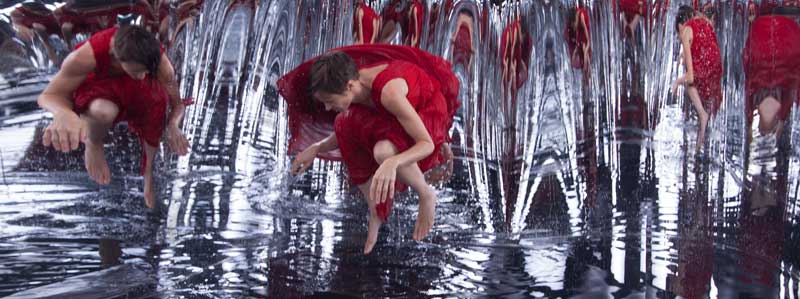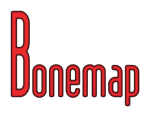BONEMAP’S FLUID HYBRIDISATION
Russell Milledge
Abstract
Can an ecological perspective provide cues for hybrid arts practice? Over the last fifteen years, Bonemap’s novel collaborative method has produced hybrid and genre independent works within the broad field of contemporary arts. Their specific creative methodology relates to a practice and process imbued with an ecological perspective. The approach incorporates a multimodal and intermedial praxis that expands static representations of human creative environments and genres. Using flux, improvisation, participatory and responsive strategies to harness generative form it is argued that Bonemap work articulate a metaphor of fluid hybridisation.
The authors cite the creative works of Bonemap and other influencers to approach contemporary arts practice with an ecological perspective producing evidence of a fluid hybridisation of artistic genre. Bonemap’s key methodological operations are responsive through the embodiment of ecological perceptions, improvisatory through the virtual and the visceral, and participatory through the experience of the implied and explicit. Practiced as spatial concepts, that inform methodological approaches to practice, Bonemap's ecological and artistic concerns consider hybridity and intermediality as linking materiality and immateriality. The evidence considers the hybrid materiality of ‘unknowing’ and ‘ephemerality’ within creative research that further challenges conventions of knowledge creation and the categorization of form. Bonemap’s methods are shown as moving towards a proposal for fluid hybridity that is set adrift in the sublime aim to articulate an ecological understanding of interconnected meaning and associations as a unique poetic vessel that bridges the interstices of genre.
Introduction
Engaging in improvisatory and participatory strategies, reflective incursions into the territory and investing in new modalities, outlines a world of practice familiar to the current orbit of contemporary arts and its global reach. Terry Smith (2011) suggests,
Art now comes from the whole world, from a growing accumulation of art-producing localities that no longer depend on the approval of a metropolitan centre and are, to an unprecedented degree, connected to each other in a multiplicity of ways, not least regionally and globally.
Curator of New York’s 2015 Armoury Focus, Omar Kholeif notes, "It is essential for one to consider alternative centres, or starting points for the history of art, as cultural output, audiences and collecting becomes more global" (Kholeif, 2014). Within this world of art, identity and place inflect the conceptual characteristics of globalisation. Elements of memory and recognition, contained in those inflections, begin to underscore a unique ecological layering within cultural territories. Smith claims, “Place making, world picturing and connectivity are the most common concerns of artists these days because they are the substance of contemporary being” (Smith, 2010). Leslie Hill, in discussing place and placelessness as it relates to live art practices, observes that “we either view places from the inside out or from the outside in…and our composite understanding of places lingers on the threshold. Its all about perspective” (Hill & Paris, 2006). This interstitial perspective is additional layering that augments universal familiarity to contemporary forms of expression. It is a position that suggests diversification rather than convergence provide new understandings within global aesthetics. Allen Carlson (2009) argues, “We must also look to ecology.” Pointing to what may be called an “ecological approach to the aesthetics of human environments” (Carlson, 2009). Carlson’s environmental aesthetics provide a perspective that “stress ecological factors as a basis for appreciating human environments not as analogous to works of art, but as integral human ecosystems.” As our view of the territory expands, and becomes more dominated by the human, new tools and ways of understanding and being in the terrain need to be incorporated into the material production of our times. Paul Carter’s characterisation of ‘material thinking’ articulates a complex drive to, “...demonstrate the great role works of art can play in the ethical project of becoming (collectively and individually) oneself in a particular place” (Carter, 2004). Carter’s sentiments indicate the role of creative process and collaboration in the formation of a “symbolic representation of the phenomenal.” For Carter engaging in collaboration exemplifies the way identity is formed and, “...to understand how relationships with others are actively invented (and therefore susceptible to reinvention), is essential knowledge if societies are to sustain themselves” (Carter, 2004).
The collaboration of artists engaged with the contemporary art group Bonemap, diversify their core investigative environment by contributing a matrix of personal and discipline specific perspectives. These individual perspectives are distinguishable in segments and layers. The collaborative methodology is additionally structured from a strata including impetus from the natural environment and the human centred spatial environment. The natural physical environment of Bonemap collaboration is often located within the geographic torrid zone of, lightly urbanised, northern Australia, including world heritage listed Wet Tropics rainforest and the off shore phenomenon of the Coral Sea’s Great Barrier Reef. The human environment, through which Bonemap perceives its flow of influence, is mediated and centred on a contemporary manifestation of art practice. The overt and encompassing environmental imperatives provide the symbolic, cultural, social and political tide as a barometer for the embodied praxis of creative production in this localisation. Bonemap operates within this ecology as an artistic collaboration that has arisen from individual practitioners actively engaged in the pursuit of innovations and renovations of artistic practice over time. The influencers and narratives include the seminal ideas of ‘re-enchantment’ that emerged with the broadening ideas of human ecology in the 80’s and 90’s. International writers and contemporary art commentators such as Suzi Gablik, (1991) attempted to articulate a rigorous proposal for a critical and creative ecological approach. Many artists such as Australian media artist Keith Armstrong provide further universal pathways for understanding art that facilitates “complex ecological concerns and social participation” (Armstrong, 2007).
Hybridisation
Bonemap’s recent activity includes hosting 'Fluid Values', the Cairns node of the 2014 Waterwheel World Water Day Symposium and contribution of a work to be experienced through the Water-wheel.net, Tap internet platform. The improvised and collaborative methodology that Bonemap draws upon is exemplified in the way it rapidly engages in mediated and telematic systems such as the Water-wheel.net Tap. Responsive performance works developed for the Tap are inclined towards entropic outcomes. This is due to the uncertain and ephemeral transaction between the maker and the participant of the live Internet Tap platform. Bonemap’s other recent works such as Nerve Engine (2013) (fig.1) have developed a level of sophistication through creative iteration, their ambitious scale and complexity amplifying the inherent multiplicity of genre and output they entail. Through this refraction we begin to approach an understanding of work within Bonemap’s field of research and practice as fluid hybridisation.
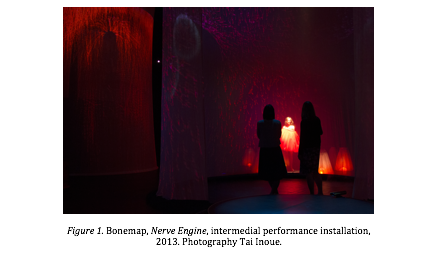 In a relationship between the vernacular of understanding and the breadth of new thought in art, there has developed a hybridisation of contemporary practice. Genres such as live art materialise form in context and backfill the widening gaps in contemporary arts understanding. Lois Keidon claims live art is, "...acknowledged as one of the most vital and influential of creative spaces, that operates in the cracks of our culture" (Keidon, 2002). For Bonemap fluid hybridisation is a rupture that renders the cracks between artistic disciplines overt, revealing fluidity where we expect to find the static. Bonemap succeeds in liberating vernacular form through the intermedial and multimodal processes of hybridisation. The Exquisite Resonance of Memory (2008) (fig. 2) is a Bonemap event liberating performance from the traditional definition of 'performing arts' and the convention of 'performance art'. In the work, a performer is present for a short moment, however, captured in motion graphics and projected indefinitely as a video wall installation around the perimeter of an architectural space. For Bonemap this is a dialectic expressed in its collaborative methodology, as the ideological tolerance between generic forms i.e. the tension between the live and the mediated. The methodology resists the patterns that categorise the common attribution of artistic genre such as ‘dance’, ‘visual arts’ or ‘live art’, even if presenters and convention cannot fail to categorise. The tension is played out in the associations that expand genres into multidisciplinary practices. Anthony McCall’s expanded cinema works from the 1970’s are an historical precedent. McCall convincingly projected solid light through haze filled rooms by reversing the focus from projection screen to projector beam (Eamon, 2005). Yet the categorisation of his works such as Line Describing a Cone (1973) as expanded cinema deemphasised McCall’s hybrid roots in performance (Eamon, 2005). The concept of perceiving light as volume rather than surface is a key hybridisation in the development of Bonemap’s latest works. For Bonemap, hybridisation positions investigation of materiality as ideological strata in the strategies for making work. Carter (2004) has suggested the process of thinking is different when making works of art. Carter’s ‘material thinking’ is multidimensional and artworks are “articulate precisely because they are articulated—jointed or joined together—in a variety of ways and dimensions” (Carter, 2004). Material thinking and ecological perspective provide processes for contemporary arts that are independent of standard categorisation. The practice bears the notion that fluidity within multidisciplinary hybridity is a sliding tolerance neither forming discrete disciplines or reliant on singular manifestations. The intellectual representations of practice indicate that multimodal competencies are a trait within Bonemap’s compositional field.
In a relationship between the vernacular of understanding and the breadth of new thought in art, there has developed a hybridisation of contemporary practice. Genres such as live art materialise form in context and backfill the widening gaps in contemporary arts understanding. Lois Keidon claims live art is, "...acknowledged as one of the most vital and influential of creative spaces, that operates in the cracks of our culture" (Keidon, 2002). For Bonemap fluid hybridisation is a rupture that renders the cracks between artistic disciplines overt, revealing fluidity where we expect to find the static. Bonemap succeeds in liberating vernacular form through the intermedial and multimodal processes of hybridisation. The Exquisite Resonance of Memory (2008) (fig. 2) is a Bonemap event liberating performance from the traditional definition of 'performing arts' and the convention of 'performance art'. In the work, a performer is present for a short moment, however, captured in motion graphics and projected indefinitely as a video wall installation around the perimeter of an architectural space. For Bonemap this is a dialectic expressed in its collaborative methodology, as the ideological tolerance between generic forms i.e. the tension between the live and the mediated. The methodology resists the patterns that categorise the common attribution of artistic genre such as ‘dance’, ‘visual arts’ or ‘live art’, even if presenters and convention cannot fail to categorise. The tension is played out in the associations that expand genres into multidisciplinary practices. Anthony McCall’s expanded cinema works from the 1970’s are an historical precedent. McCall convincingly projected solid light through haze filled rooms by reversing the focus from projection screen to projector beam (Eamon, 2005). Yet the categorisation of his works such as Line Describing a Cone (1973) as expanded cinema deemphasised McCall’s hybrid roots in performance (Eamon, 2005). The concept of perceiving light as volume rather than surface is a key hybridisation in the development of Bonemap’s latest works. For Bonemap, hybridisation positions investigation of materiality as ideological strata in the strategies for making work. Carter (2004) has suggested the process of thinking is different when making works of art. Carter’s ‘material thinking’ is multidimensional and artworks are “articulate precisely because they are articulated—jointed or joined together—in a variety of ways and dimensions” (Carter, 2004). Material thinking and ecological perspective provide processes for contemporary arts that are independent of standard categorisation. The practice bears the notion that fluidity within multidisciplinary hybridity is a sliding tolerance neither forming discrete disciplines or reliant on singular manifestations. The intellectual representations of practice indicate that multimodal competencies are a trait within Bonemap’s compositional field.
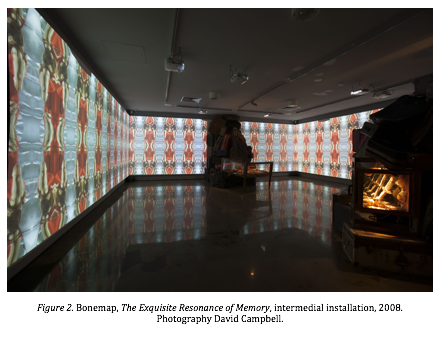
The Bonemap projects Terrestrial Nerve (2013) and Nerve Engine (2013) (fig. 1) exemplify a hybrid process. Developed as integrated components, these works allow presentational elements to morph between the specifics of public and private space such as the art museum, performance space, small screen and cinema. However, the hybrid work is best described as a form much more ephemeral. It includes a responsive environment with input and output sequences specific to the time and place of audience participation and engagement. The multimodal status of the works includes a series of time-based media that can be presented in the art gallery, online or performed as a spatial projection. In an expansion of genre, Bonemap’s responsive environments are intrinsically more ephemeral and improvisatory, requiring systems of immediate generative content and interaction. It is this linking of the generative moment, a physical connection between the performed, the participated and the responsive manifestation of space that fluidly hybridises at the moment of perception.
The attributes of responsive presentational output, and participant engagement are found in the Water-wheel.net Tap developed through the deft direction of Belgian/Australian intermedia artist Suzon Fuks’s. The collaborative online interface of the Tap has drawn the attention of Bonemap artists since its inception in 2011. Bonemap artists have been both collaborators and peer reviewers in the developmental stages of the Water-wheel.net Tap. During a node of 2014 Waterwheel World Water Day Symposium, Fluid Values Bonemap performed the telematic work ‘The exquisite liquid, song for water’ (2014). During the development of the work generative and live data processing highlighted complexities bringing together an online participatory audience and local generative performer in real time, through the Water-wheel Tap online interface. The interface itself allows interactivity through collaborative tools. However, these tools are limited to user graphical interface elements accessible, at the time, only by invited ‘crew’ subscribers to the Tap event. Scripted motion graphics can be integrated, but in current iterations of the platform, deployed as packets of code to each end users/audience browser without visual feedback to the host, just local interactivity. Each end user can have their own interaction with scripted (ActionScript) motion graphics content independent of the host performance but concurrently overlayed on it. The mixed use of the Water-wheel Tap sets up a particular expectation of approach and etiquette where online audiences are both individual (with their own PC interface) or in a group and at a remove with a data projection or other communal screen experience. These variables require a particular integrated narrative to alert each end user potential to the initialisation of appropriate reactive response.
In the work, ‘The exquisite liquid, song for water’ (2014), the Bonemap performer improvises with the web feed lens, where an extreme close-up of the performers eye metaphorically represents a body of water. The isolation of the eye in the framing of the lens challenges the performer to consider in what way can the pupil perform? The performers impetus is internal imagery and the convention of audience feedback is deferred. What are the observations of the online viewer and the offline performer that happen in concert? The live feed of the performance was also layered with generative content developed from ActionScript. Geometric circular forms (representation of bubbles) detect and bounce off each other using collision detection algorithms. The development of the work considered embodied strategies to allow sensorial encounters to occur through the ‘in’ and ‘out’ space of online telematics. Suzon Fuks’s (2014) review of Bonemap’s ‘The exquisite liquid, song for water’ articulates the work as “the interactivity between elements, the specificity of the streaming technology and agency of the public.” Noting that, “prepared scripted animations … activated by online audience, and ‘patches’ to process media live and to layer them even more than what the Tap tools already offer.” Fuks interpreted the work as, an “underwater soundscape, animated cartoon bubbles escaping the stage window, magnifying body close-ups of [the performer] with an iPod camera. Her playful presence, improvisation qualities and attention to the overall rendered moving imagery, demonstrated her experience as an online performer.” The process for ‘The exquisite liquid, song for water’ is equally concerned with the internal generative contribution of improvised choreography by the live performer in unity with the artistic manipulation of the mediatised system or ‘digital engine’ that facilitates the telematic event through the Tap interface. The nodal communication of telematic performance and participatory engagement, assisted through the Tap, exemplifies the interrelations that mark an ecological notion of fluid hybridization in this context.
Hybrid fluidity, as the intermedial and materiality of Bonemap’s process, is initiated by engaging in the primary progression of a collaborative multidisciplinary process. The collaborative process is reflective and multimodal. Gathering the thoughts of participating artists may reveal concerns associated with phenomenology, aesthetics, representation, ecology, performance, and communications theory, amongst others. These modalities, as value chains and intellectual adventures, make many disparate symbolic platforms suitable for the hybrid matrix Bonemap generates. This suggests the tolerances of individual modalities within the matrix are active enough to establish and materialise interstitial resonances. These resonances are the frequencies established for the symbolic and participatory regimen of the creative research. The creative process is a collaboration that is given the space and time to lead to its own devices through iteration and unfolding inference. The Bonemap project Rupture and Residue (2005) developed a natural environment model of environmental aesthetics as an improvised investigation of the dancing body in a surrounding environment and the extension of the body and surround through media. The creative process was dissociated from specific expectations and standardised outcomes. The collaborators were inhabitants of a communal journey through time, space and material event. During, and as a consequence, of the projects hybrid fluidity many rhizomatic connections and offshoots developed at nodes with their own evolutionary trajectory. For example a significant and unexpected growth trajectory harvested a representational node of the work as a manifestation of mural photography in a commission for a large convention centre (fig. 3).
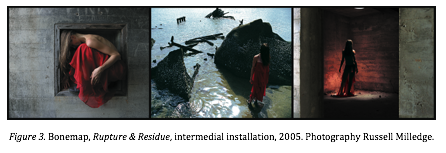
Ecology
Bonemap’s engagement within an ecological perspective can be interpreted as an experiential field that reconciles organism with environment through the praxis of making art. Erin Manning and Brian Massumi (Manning & Massumi, 2014) describe ‘ecological experience’ as an,
...intertwining of fields of emergent experience not yet defined as this or that…yet their qualities already interact. The fields, in their immediacy, play off each other, lending their qualities to each other, composing a single field of mutual action, of co-fusion and changing contrast: co-motion.
An ecological perspective in this praxis includes the significant embodiment of artistic engagement within an endemic interrelationship to time and place—a relational field. This is what Carter (2004) describes as “the impulse to identify poiesis, or ‘making’ with place-making” in the expression of being and the process of becoming.
To record fluid hybridity in creative research, as two-dimensional text, risks forfeiting the distinctive quality of its material unity, its dimensionality in ecological space. However, the imperative to reconcile the ecological relation of the human and natural environment has been articulated by various authors over a sustained period after modernism. Morris Berman (1981), Suzi Gablik (1992) and Keith Armstrong (2007), amongst many others, provide a cogent and forceful challenge to the supremacy of mechanistic scientific and commercial attitudes as the basis of relational consciousness to nature. Science’s empirical emphasis on truth-value within a fixed mechanistic world-view focuses on the edict that we can only know the natural world by distancing ourselves from it. To relate the process of making art to the practice of science is, for Carter (2004), to “conceive of the work of art as a detached datum” that fails to acknowledge, “that the work of art begins as a social relation.” Biologist Rupert Sheldrake (1993) discusses this divisiveness as it relates to "disembodied science" articulated as a separation of nature as 'other', 'inanimate' and 'object'. Art-science projects such as those proposed by Armstrong (2007) seek to reconcile ecological alterity through the perspective of a co-fusion of creative and scientific research concerns. Armstrong described his art practice as,
... Focused around the understanding that our ecological crisis is also a cultural crisis, perpetuated by our sense of separation from the material and immaterial ecologies upon which we depend. This misunderstanding of relationships manifests not only as environmental breakdown, but also in the hemorrhaging of our social fabric. (Armstrong, 2007)
The embodiment of an ecological awareness invokes a methodology of practice beyond the separation of subject/object, organism/environment and animate/inanimate. An important consideration for Bonemap’s creative research is the principal of locating knowledge within spatial and temporal interrelationships. Manning & Massumi (2014) consider ecological experience in the immediateness of the environment as a mode of attentiveness.
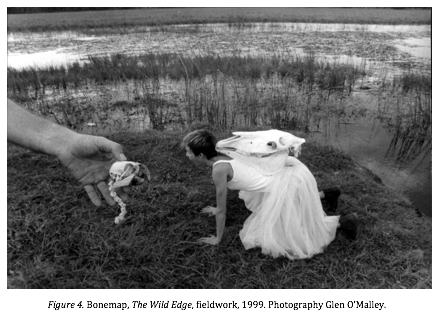 A dance of attention is the holding pattern of an immersive, almost unidentifiable set of forces that modulate the event in the immediateness of its coming to expression. Attention not to, but with and toward, in and around. Undecomposably.
A dance of attention is the holding pattern of an immersive, almost unidentifiable set of forces that modulate the event in the immediateness of its coming to expression. Attention not to, but with and toward, in and around. Undecomposably.
The body and surround represents the material condition central to a spatial field in the participatory art events seminal to the Bonemap project. For exampe, The Wild Edge (1999) (fig.4) was an event engaged with creative research through accessing out-of-awareness perceptions. Time, place, space and sensorial sensitivty beyond habitual movement and experience, were the centre of investigation. The Wild Edge incorporated intense fieldwork and inhabitation in remote environmental locations and journeys over great distances. The projects process methodology aimed at imbuing the artists within a direct and sustained interface with natural conditions, situations and phenomena. This included the ecology of experiences that honour and emphasise subtle and ethereal interventions and interrelationships in the natural world. The Wild Edge and a number of seminal events during the 1980’s and 90’s, signalled for Bonemap an embodiment of practice that had moved away from the production of artifacts and objects, towards the attunment of experiences. It sought to place subjective arts practice firmly in a non-linear space/time continuum as integral to the unnamable flux that constitutes natural environments. An early influencer on the gathering of Bonemap artists was Japanese dancer Min Tanaka in the 1980’s—90’s. The experiences with Tanaka revealed embodied techniques to heighten sensorial awareness of physical environmental conditons. Tanaka said, "I don’t dance in the place, but I am the place" (Viala & Masson-Sekine, 1988).
The experiences of engageing with Tanaka’s method revealed the discontinuity of time perception. His techniques allow shifts within the presence of the performer, who may imaginatively control recognisable body/time/space rhythms. The technique, described by Tanaka as ‘image work’ or ‘imaginations’, substitutes the reaction of sense receptors, such as the dancers skin, with the imagination of kinesthetic impulses. The aim of the technique is for the dancer to become integrated into the environment or move the environment around and through the body. Physical bodywork within Bonemap’s fluid hybridisation is a contribution to the temporal structure of the relational field where the kinesthetic marks a mode of choreographic extension within connections and influences, impacts and subtleties. An example of subtle kinesthetic impact has been articulated by Madeline Gins and Arakawa in their philosophical treatise Architectural Body (2002). Like Tanaka’s ‘image work’ and embodiment of environment in dance, Arakawa and Gins (2002) describe "imaging landing sites" as imaginative substitution for kinesthetic vectors. They explore awareness as "events composed of kinesthetic- and proprioceptive- perceptual landing sites" in their articulation of subject and surround. Their thoughts are linked to the design of architecture, however moving the design process to a hybrid multimodal consideration of the fluid spatial trajectories particular to the choreographic and kinesthetic impact within ecological spaces.
Conclusion
Writing of the ecological perspective within hybrid arts practice, as a process of creative research, becomes a double movement that dissects the thinking and articulates the fluid strata of relations in a compositional field. The examples of practice provided by Bonemap’s sustained engagement over time demonstrate how an ecological approach interrogates a compositional field providing a mode of operation for the organisation and representation of its hybridity. The structure of fluid hybridity has been demonstrated, through examples of contemporary arts from historical and current practice, as intermedial and multimodal, but also as temporal and shifting. This multiplicity is recorded as being a common current in contemporary arts at the beginning of the 21st Century.
Figures
Figure 1. Bonemap, Nerve Engine, intermedial performance installation, 2013. Photography Tai Inoue.
Figure 2. Bonemap, The Exquisite Resonance of Memory, intermedial installation, 2008. Photography David Campbell.
Figure 3. Bonemap, Rupture & Residue, intermedial installation, 2005. Photography Russell Milledge.
Figure 4. Bonemap, The Wild Edge, fieldwork, 1999. Photography Glen O’Malley.
References
Armstrong, K. (2007) Grounded Media: Expanding the scope of ecological art practices within new media arts culture. In Hutchinson, Andrew, Eds. Proceedings Perth DAC 2007: The 7th International Digital Arts and Culture Conference: 'The future of Digital Media Culture'. Perth. Australia. Accessed from http://eprints.qut.edu.au/8802/
Berman, M. (1981). The Re-enchantment of the World. Cornell University Press. Ithica, New York.
Bonemap. (2003). Bridge Song. In Ecological Manifesto: Bonemap's Ecological Hybridisation - an approach to contemporary art practice.Accessed from http://www.bonemap.com/bridge/txApproach.html
Carlson, A. (2000). Aesthetics and the Environment, The appreciation of nature, art and architecture. Routledge. London and New York.
Carlson, A. (2009). Nature and Landscape : An Introduction to Environmental Aesthetics. New York, NY, USA: Columbia University Press. ProQuest ebrary. Web. 6 October 2014.
Eamon, C. (2005). Anthony McCall The Solid Light Films and Related Works. Northwestern University Press, IL, New Art Trust. San Franscisco, CA, USA.
Fuks, S. (2014). #22 Session – Fluid Values. http://blog.water-wheel.net/2014/07/reviews-of-3wds14-symposium.html
Fuks. S. (2014). Waterwheel. http://water-wheel.net/
Gablik, S. (1991). The Re-enchantment of Art. Thames and Hudson. London and New York.
Gins, M. and Arakawa. (2002). Architectural Body. Tuscaloosa: The University of Alabama Press. AL, USA.
Hamilton, J. (2006). Intimate Transactions: Art, Exhibition and Interaction within Distributed Network Environmnets. Australian CRC for Interaction Design. Brisbane, Australia.
Hill, L. and Paris, H. (2006). Performance and Place. Palgrave Macmillan. London, UK.
Keidon, L. and Brine, D. (eds). (2002). Exposures. Live Art Development Agency. Black Dog Publishing, London, UK.
Kholeif, O. (2014). Omar Kholeif, Curator at the Whitechapel Gallery, London Appointed Curator of Armory Focus. The Armory Show. press release. October 1, 2014. Accessed from http://www.thearmoryshow.com/press/press_releases.html
Manning, E. and Massumi, B. (2014). Thought in the Act : Passages in the Ecology of Experience. Accessed from http://www.eblib.com
Sheldrake, R. (1993). The Rebirth of Nature: New Science and the Revival of Animism. Rider. London and Sydney.
Smith, T. (2009). What is Contemporary Art? The University of Chicago Press. Chicago.
Smith, T. (2010). The State of Art History: Contemporary Art. Art Bulletin, vol. XCII, no. 4, p. 380.
Sponsors: Centre of Contemporary Arts, School of Creative Arts James Cook University

